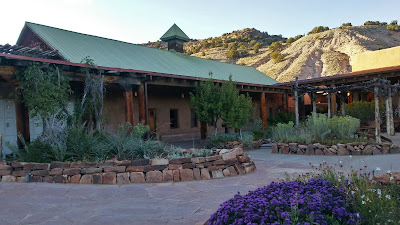Sanctuario de Chimayo
Tucked into the foothills of the Sangre de Cristo mountains, the village of Chimayó may seem far off the beaten track as we drove along the tree line winding road.
Known as the “Lourdes of America,” el Santuario de Chimayó, 40 miles north of Santa Fe, New Mexico, is one of the most important Catholic pilgrimage sites in the world. Even so, it is unknown to most Americans.
Each Holy Week, Chimayó, a tiny town of 3,000, swells to more than 40,000 as the annual pilgrimage fills the high desert roads of Northern New Mexico with the faithful. Many of the pilgrims walk hundreds of miles to visit the site. To read more about the miracles click here.
It was a short drive from Ojo Calliente to the mission.
The site was declared a National Historic Landmark in 1970
The Three Cultures Monument, depicts the meeting of a Native American, a white cowboy, and a Hispanic vaquero under a benevolent figure of the Virgin Mary.
Calls for prayers for the ill and troubled are posted
The Santuario is known for its healing dirt. The tradition of the healing dirt continues to this day.
Off to the side of the altar is a doorway leading to a small prayer room with a wall of cast off crutches, and an entrance to el pocito, or “the little well,” of healing dirt.
Some pilgrims take vials of the sand with them as a remembrance. Fortunately, there is plenty of soil available to satisfy the ongoing demand. The Church replaces the dirt in the pocito from the nearby hillsides, there are 5 gallon buckets in the back of the church to bring more dirt when needed. We left our share for someone else.
Chimayó is also famous for high-quality weaving, red chili, horse and sheep raising, and fruit orchards.
The Santo Niño Chapel is just a short walk from el Santuario honoring children with many baby shoes hanging on the walls.
The story of the Santo Niño begins in Spain during the time of the Moors, Spain's Muslim conquerors. In Atocha, outside Madrid, many Christian men had been imprisoned. The jail did not feed the prisoners, and the caliph ordered that only children could visit and bring food to them. The women prayed to Our Lady for help. Soon word spread that a small boy was visiting and feeding the prisoners. His basket was never empty of bread, and his water gourd was always full. He was considered a manifestation of Jesus as the Holy Child, the Santo Niño.
Don Bernardo Abeyta statue was builder of Sancuario de Chimayo.
Walkway along the river.
Ortega's Weaving
Not far from the Santuario is Orteg's weaving where we made a quick stop.
In the early 1700's, Gabriel Ortega was among a group of settlers who came to the Northern Rio Grande Valley to settle in what is now Chimayo, New Mexico. In those days Chimayo and the surrounding area were the last frontier of New Spain. Life was difficult which meant Gabriel Ortega needed to be self-sufficient. One of the skills needed to survive was weaving, with which they made clothes, blankets, rugs and even mattresses.
In the early 1900's, Nicacio and Virginia, who were also from a weaving families, opened a general store in Chimayo. Nicacio had a loom in his store and sold his weavings along with those of his sons, relatives and friends. The demand kept growing as more people discovered Santa Fe and New Mexico.
Everything on dispaly was very nice quality.
Black Mesa Winery
It was a sightseeing day and we also stopped at the winery.
Most of the grapes had been harvested except the Montepulciano grapes. I tasted a grape while walking though the vines and thought they tasted better than the wine.
Behind the winery is a trail that winds between over 300 petroglyphs.
Labyrinth along the trail. We are near Santa Fe. A labyrinth is a given.
Driving through the area, we saw so many apples trees. This area is known as the apple orchard area. The winery put out a call for apples from the surrounding area for their hard cider "Bit Me" which we purchased. It must have gotten its bite from the harsh sunny conditions of the area. We also found a white wine we both liked very much.
One of America's best diners
The winding highway meandered alongside the murky river to Embudo, NM. We smelled the hazy smoke plumes coming from Sugar’s BBQ & Burgers.
It was recognized as one of America’s ten best drive-ins by Gourmet magazine. We chose the brisket burrito in which tender brisket, green chile and shredded cheddar cheese piled high on a fresh tortilla. They were so large that we had the second half the next day. I know, not exactly heart healthy but very tasty.
A fitting end to a great morning. Lunch under a tree as the breezes cooled us as we enjoyed the changing of the fall colors.
I hope I haven't bored you with my little history. We just find learning about the past makes our adventures even more memorable.
































































